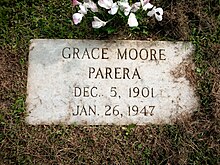Grace Moore

Mary Willie Grace Moore ( December 5, 1898 in Slabtown , Tennessee – January 26, 1947 at Copenhagen-Kastrup Airport on Zealand , Denmark ) was an American opera singer (soprano) and actress of the 1930s.
Life
Grace Moore, whose year of birth differs, originally wanted to be a missionary in China. Eventually she quickly made a career as a lyric soprano on both Broadway and the Metropolitan Opera . Her good looks earned her a contract with MGM in 1930 , who used her in two lavishly produced operettas. In A Lady's Morale she played the well-known Swedish nightingale Jenny Lind and in New Moon she was the partner of Lawrence Tibbett , another opera star who had gone to film. However, the contract was terminated soon thereafter citing a "weight problem".
She made a successful return to the Met and started a very popular radio show that brought classical music to a wider audience. At the height of her career and several pounds lighter, she signed a deal with Columbia Pictures and directed the 1934 film One Night of Love , which would make her a Hollywood star practically overnight. In the role of a spirited young woman aspiring to be a singer, Moore practically played herself. She performed both classical arias and modern songs, including Ciri, Biri, Bin , which would eventually become her signature song and trademark of her touring performances . Moore was nominated for an Oscar and renegotiated her contract.
Immediately following the success of One Night of Love , Irving Thalberg wanted Grace Moore for the lead role in the operetta The Merry Widow , partnering Maurice Chevalier and directing Ernst Lubitsch . However, since both Moore and Chevalier had a first-announcement clause in their contracts, the role eventually went to Jeanette MacDonald , who was subsequently set up in response to Grace Moore. Over the next few years, Grace Moore made a number of very popular films that helped incorporate classical music, and especially arias, into the plot without alienating audiences. She probably had her best role in 1936, directed by Josef von Sternberg , in The King Steps Out , the film adaptation of a libretto by Heinz Marischka about the Bavarian princess Sisi, who later became Empress Elisabeth of Austria. Moore's success also prompted other film studios to also get sopranos in front of the film camera. However, neither Lily Pons , who was signed to RKO , nor Gladys Swarthout , who would be built to stardom by Paramount , had any real success at the box office.
After ending her film career, Grace Moore embarked on commercially successful tours around the world. She wrote her biography You're Only Human Once in 1944 and died three years later in the Kastrup air disaster near Copenhagen . Her remains were transported to her home country and interred with great care next to her father's in Forest Hills Cemetery in Chattanooga , Tennessee. She bequeathed most of her inheritance, valued at $500,000 at the time, to her husband.
Grace Moore was married to Spanish film actor Valentín Parera (1895–1986) from 1931 until her death and lived alternately in the United States and Europe. The marriage remained childless. On December 16, 1943, both survived the Rennert ( North Carolina ) railroad accident with minor injuries, in which 74 people died.
Moore's life was filmed in 1953 under the title So This Is Love , starring Kathryn Grayson .
In 1947, the year of Moore's death, a rose was named after her. There is also a persistent rumor that she acted as the namesake for Elvis Presley's Graceland estate .
filmography
- 1930: New Moon
- 1930: Jenny Lind (A Lady's Morals) (as Jenny Lind )
- 1934 One Night of Love
- 1935: Love Me Forever
- 1936: The King Steps Out
- 1937: I'll Take Romance
- 1937: When You're in Love
- 1939 Louise
web links
- Grace Moore at theInternet MovieDatabase
- Grace Moore . In: Virtual History
- Grace Moore on Operissimo based on the Great Vocal Dictionary
itemizations
- ^ See Grace Moore's Estate Probated at $ 500,000 . In: The Washington Post , March 27, 1947, p. 9.
- ↑ cf. Glamor Singer rose from Choir . In: Los Angeles Times , January 27, 1947, p. 2.
- ↑ cf. Rose to Be Named Grace Moore . In: The New York Times , September 20, 1947, p. 18.
| personal data | |
|---|---|
| SURNAME | Moore, Grace |
| ALTERNATIVE NAMES | Moore, Mary Willie Grace (full name) |
| BRIEF DESCRIPTION | American opera singer (soprano) and actress, 1930s |
| BIRTH DATE | December 5, 1898 |
| PLACE OF BIRTH | Slabtown , Tennessee |
| DATE OF DEATH | January 26, 1947 |
| PLACE OF DEATH | at Copenhagen-Kastrup Airport on Zealand , Denmark |
